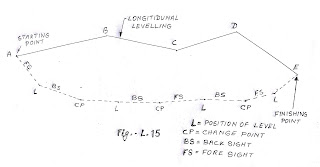TYPES OF LEVELING OPERATION
(1). Simple levelling: When the difference of level between two points is determined by
setting of levelling instrument midway between the points, the process is
called simple levelling.
Suppose A and B are two points whose difference
of level is to be determined. The level is set up at O. After proper temporary
adjustment the staff reading on A and B are taken. The difference of level
between A and B (Fig. - L.10).
(2). Differential levelling: Differential levelling is adopted when (i) the points are a great distance apart, (ii) the difference of elevation between the points is large, (iii) there are obstacles between the points.
This method is also known as compound
levelling or continuous levelling. In this method the level is set up at
several suitable positions and staff readings are taken at all of these.
Consider Fig.- L.11. Supposed it is required to know the difference of level
between A and B. The level is set up at points O₁, O₂, O₃, etc. After temporary
adjustments, staff readings are taken at every set up. The points C₁, C₂ and C₃
are known as change points. Then the level between A and B is found out. If the
difference is positive, A is lower than B. If it is negative, A is higher than
B.
Knowing the RL of A, that of B can be
calculated.
(3). Fly levelling: When differential levelling is done in order to connect a bench mark to
the starting of the alignment of any project, is called fly levelling. Fly levelling
is also done to connect the BM of any intermediate point of the alignment for
checking the accuracy of the work. In such levelling only the back-sight and
fore-sight readings are taken at every set up of the level and no distances are
measure along the direction of levelling (Fig.
– L.12). The level should be set up just midway between the BS and the FS.
(4). Longitudinal or profile levelling: The operation of taking levels along the centre line of any alignment
(road, railway, etc.) at regular intervals is known as longitudinal levelling.
In this operation, the backsight, intermediate sight and foresight readings are
taken at regular intervals, at every set up of instrument. The chainages of the
points are noted in the level book. This operation is undertaken in order to
determine the undulation of the ground surface along the profile line (Fig. – L.13).
(5). Cross-sectional levelling: The operation of taking levels transverse to the direction of
longitudinal levelling, is known as cross-sectional levelling. The
cross-sections are taken at regular intervals (such as 10 m, 20 m, 40 m, 50 m,
etc.) along the alignment. Cross-sectional levelling is done in order to know
the nature of the ground across the centre line of the alignment (Fig. – L.14).
(6). Check levelling: The fly leveling done at the end of the day’s work to connect the
finishing point with the starting point on that particular day is known as
check levelling. It is undertaken in order to check the accuracy of the day’s
work (Fig. – L.15).
(Next post
on “PRINCIPLE OF EQUALISING BACKSIGHT AND FORESIGHT DISTANCES”)










Nice information
ReplyDeletesurveying and levelling questions | Exam test